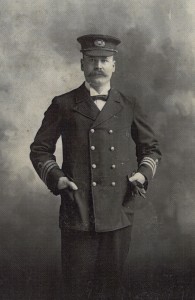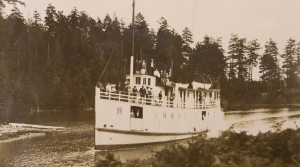Sinking Steamer Lingers 100 Years

Photo: P011 8 1 - Captain Sears in Uniform
Author: Brad R. Morrison, Sidney Archives Manager and Citizen Journalist
Did the news media direct public opinion of the Steamer Iroquois disaster 100 years ago?
There have been several noteworthy news items concerning the Saanich Peninsula over the years, but none have been so extensively published as the sinking of the Steamer Iroquois and the loss of about 20 passengers and crew. Why was this the case? Was there something special or significant concerning this particular event?
On the stormy morning of April 10, 1911, at 9 o’clock, the Steamer Iroquois left the dock at Sidney on its regular route through the Gulf Islands to Nanaimo. Within 15 minutes, while still in view of the dock, the Iroquois listed to one side and eventually sank not far from the entrance of Canoe Pass. The local newspapers had a heyday displaying sensational headlines designed to shock their readers. “Score Perish As Ship Goes Down,” “Women Closed In Like Rats,” “Inquest Shows Captain Deserted Iroquois Wreck – Rowed Away in Lifeboat, Leaving Passengers to Be Rescued by Indians”. These headlines invoked the news of the sinking to become international news, appearing in major newspapers in eastern Canada, United States, Britain, Australia and New Zealand the next day.
As the result of the publicity, Captain Albert A. Sears seemed to be singled out and portrayed as a “villain” and singularly responsible for the tragedy. Ultimately the Captain of a ship is the one liable, yet to publicly declare him a murderer among other contemptible terms were uncalled-for. Sears no doubt, was used as an example because of the sinking of the Steamer Sechelt (a very similar shape and size vessel) three weeks previous with the loss of all aboard near Sooke and of whom there was no one surviving to cast the blame on. The details and accounts from witnesses of the Iroquois disaster were at first fragmentary, being revised with each ensuing issue of the daily journals.
On April 11, the day after the tragedy, David L. Jones, the president of the Victoria Shipmasters Association, privately wrote Justice Martin, whom later was appointed the overseer of the Admiralty investigation trial on the disaster. “The public have been interviewing me as regards the most satisfactory manner of dealing with the above disaster, they evidently not being at all satisfied with the investigation held by Capt. Eddie on the Sechelt Case” as it was held behind closed doors.
""
Jones pointed out that Charles H. Lugrin, the managing editor of the Daily Colonist, had wired Ottawa “asking that or rather, I might say … demanding an investigation to be held” within the public view. In Lugrin view, someone had to be held responsible, and he was determined to force the issue through the media.
After several public trials with the dramatic accounts being reported in the local papers, Captain Arthur A. Sears was acquitted of manslaughter. He was found guilty of negligence and failing to perform his duty regarding the saving of his passengers in the Admiralty Court, resulting in the cancellation of his Master’s Certificate.
One can only wonder to what extent the local news media of the past influenced events other than the sinking of the Steamer Iroquois. Another example could be made of how the news media used Aboriginal issues during the late 1850’s and early 1860’s to manipulate public opinion. Doctoral candidate Kenton Storey has been investigating how the “print culture” of that time directed public opinion. Through his research, he illustrates how some editorials were written for the distinct purpose of instilling fear in the white settler community around Victoria, insisting that men, women and children were not safe from being molested and/or killed by the native people. This was one of the means, wherein pressure was applied against Governor Douglas, demanding him to install measures and remove the native presence in order to prevent such occurrences. Thus a large amount of valuable land became available to be purchased.
As the old adage states: “The pen is mightier than the sword.” May we be wary of bona fide truth when underlining motives may be hidden just beyond sight.

Photo: P011 9 - Steamer Iroquois
For further information concerning the Steamer Iroquois and many other subjects about the history of Sidney and the Saanich Peninsula visit the Sidney Museum www.sidneymuseum.ca or call the Sidney Archives at 250-656-1322.













